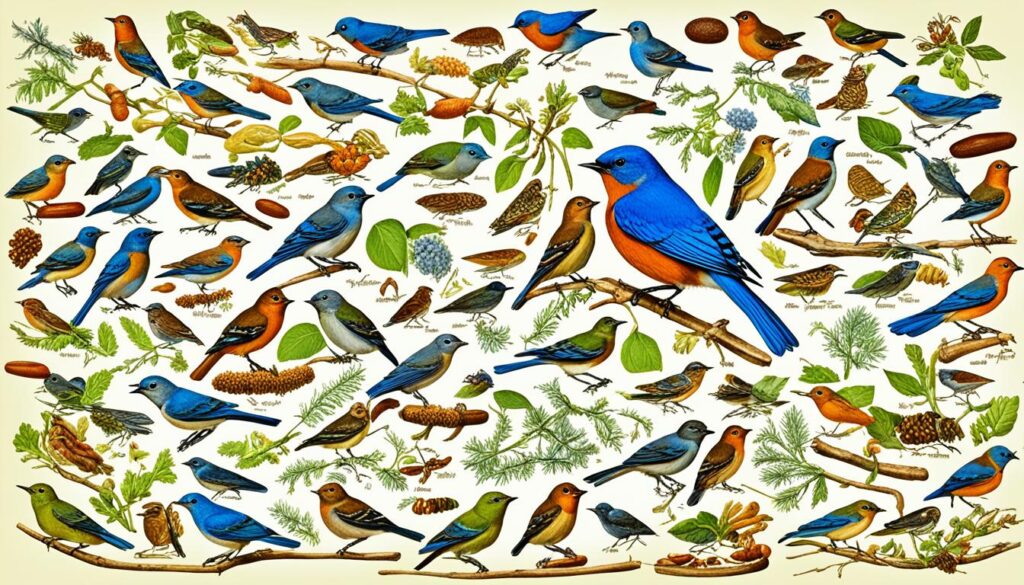Bluebirds play a big role in keeping garden pests in check by eating lots of insects each day. This helps the ecosystem stay healthy. They’re not just pretty to look at in your yard. Their diet shows how they can eat many different things. They eat mealworms, suet, berries, and even eggs. Let’s dive into what blue birds eat and how to help them.
Key Takeaways
- Bluebirds can find enough food during warmer months, but may benefit from supplemental feeding during harsh conditions
- Mealworms are a favorite food source that bluebirds will readily eat year-round
- Suet and scrambled eggs can provide high-energy sustenance for bluebirds in cold, wet weather
- Bluebirds enjoy a variety of seeds, berries, and fruits, especially in the fall and winter months
- Specialized feeders can help ensure bluebirds have access to their preferred foods
Introduction
Bluebirds are adored for their vibrant plumage. They eat a variety of foods throughout the year, fitting to their changing environment. Learning about what bluebirds eat can teach us a lot, which is great for bird watchers and nature lovers.
Overview of Blue Bird Diet
Bluebirds mainly eat insects and small invertebrates. This is especially true during the time they’re caring for their young. In warmer months, they feed their babies insects to help them grow fast.
When it gets colder and bugs are harder to find, bluebirds switch to foods like suet and mealworms. This keeps them strong and active.
They also enjoy wild fruits and berries, mostly in the autumn and winter. These foods are full of carbs and vitamins, helping bluebirds stay healthy in the cold.
So, knowing what to feed bluebirds can make your backyard a welcoming place for them. It’s a great way to connect with these beautiful creatures.
Meal Worms: A Favorite Treat
Bluebirds love meal worms because they are nutritious. You can buy them at most pet stores, bait shops, or online. Always put meal worms in a dish with smooth sides to keep them from getting away.
Feeding meal worms to bluebirds in the same spot every day teaches them where to find food. Do this in the morning, when they’re hungry and there’s less competition. Storing meal worms in the fridge keeps them fresh longer.
Sourcing and Feeding Meal Worms
You can get a large amount of mealworms online for about $40. The more you buy, the lower the price per worm. They are full of protein, from 20% to 48%, perfect for bluebirds.
Bluebirds prefer live mealworms but can eat dried ones too. Keeping meal worms in the fridge makes them last longer. This avoids them turning into pupae accidentally.
- Mealworms offer a protein-rich supplemental food for bluebirds
- They can be purchased from pet stores, bait shops, or online suppliers
- Place mealworms in a shallow dish or specialized feeder with smooth sides
- Feed mealworms at the same time and location each day, preferably in the morning
- Refrigerate unused mealworms to extend their shelf life
| Mealworm Feeding Tip | Benefit |
|---|---|
| Feed mealworms at the same time and location daily | Helps bluebirds associate the location with a reliable food source |
| Offer mealworms in the early morning | Bluebirds are often hungry then and face less competition from other birds |
| Store unused mealworms in the refrigerator | Keeps the worms dormant and extends their shelf life |
Giving bluebirds meal worms is a fun way to watch them and take photos. But, remember, only feed them mealworms in moderation. Mealworms are low in calcium and hard to digest.
“Offering mealworms may encourage wild bluebirds to nest closer to human habitats, potentially leading to second and third broods.”
Suet: A High-Energy Food
When it gets colder and bugs are hard to find, bluebirds might start eating suet. This food is full of energy. It comes in feeders with things like sunflower seeds, peanut bits, and raisins. This mix gives bluebirds a jump-start in the winter.
Suet is not top of the list for bluebirds in the summer. That’s because they have plenty of insects then. But come winter, offering suet can draw them to your yard. You can make your own suet. This lets you use the best ingredients for your backyard bird friends.
| Suet Ingredient | Benefit for Bluebirds |
|---|---|
| Rendered Suet | High-energy fat content provides essential calories |
| Crunchy Peanut Butter | Protein-rich and appealing to bluebirds |
| Cornmeal | Provides carbohydrates and texture |
| Chopped Nuts | Offer additional fats and proteins |
| Dried Fruits | Provide natural sugars and vitamins |
To keep squirrels away, some suet recipes use bird chilies. This strong-flavored suet is still safe for backyard birds. Remember, suet is a good pinch hitter, not a main meal. Birds need a variety of food for their best health.
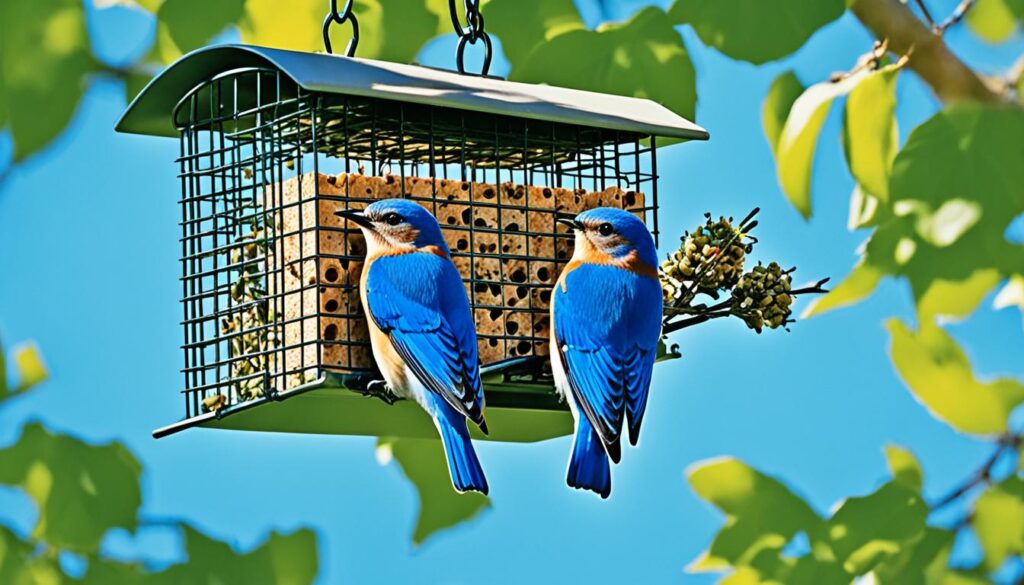
“Suet is particularly attractive to woodpeckers, nuthatches, chickadees, jays, and starlings. The animal fat in suet is easily digested and metabolized by many birds, making it a high-energy food that is especially valuable in cold weather.”
Scrambled Eggs for Harsh Conditions
In cold weather with limited food, bluebirds need our help to survive. Giving them scrambled eggs can be a big difference maker. They happily eat it and feed it to their babies.
Scrambled eggs are great for bluebird supplemental feeding. They offer the protein-rich bird food bluebirds require in the cold. By providing this, you promote the health of bluebird chicks and help with backyard bird conservation.
- Prepare the scrambled eggs by cooking them thoroughly until firm, then allowing them to cool completely.
- Place the cooled, scrambled eggs in a tray-style feeder near the bluebird’s nesting area.
- Monitor the feeder to ensure the eggs are consumed within a day or two, and remove any uneaten portions to prevent spoilage and the potential attraction of unwanted predators.
“One case of a parrot dying from eating eggs due to strokes was described after being fed eggs weekly. An avian vet mentioned that the arteries of the parrot that died from a stroke were full of plaque from consuming eggs.”
Eggs can be tricky with birds, but bluebirds really like them when food is scarce. By offering scrambled eggs, you’re supporting their nutrition in tough times. Plus, you help with backyard bird conservation in your area.
Bird Seed and Berries
Bluebirds love bugs but will also snack on seeds and berries, especially in cold times. With fewer insects around, these foods help keep them going strong. They adore particular seeds and berries that boost their energy for their active lives.
Types of Seeds and Berries Blue Birds Enjoy
Bluebirds enjoy sunflower hearts, softened raisins, and sometimes peanut chip or nut meat. But, seeds and berries aren’t the main part of their diet. They mostly rely on wild berries and other natural fruit sources.
Bluebirds are big fans of plants like dogwood, holly, mulberry, wild grape, Virginia creeper, pokeweed, and Viburnum. These plants are like a buffet for them, adding variety and nutrition when their usual food is scarce.
If you plant the right seeds and berries, you’re creating a year-round meal plan for bluebirds. This ensures they stay healthy and happy in your yard, no matter the season.
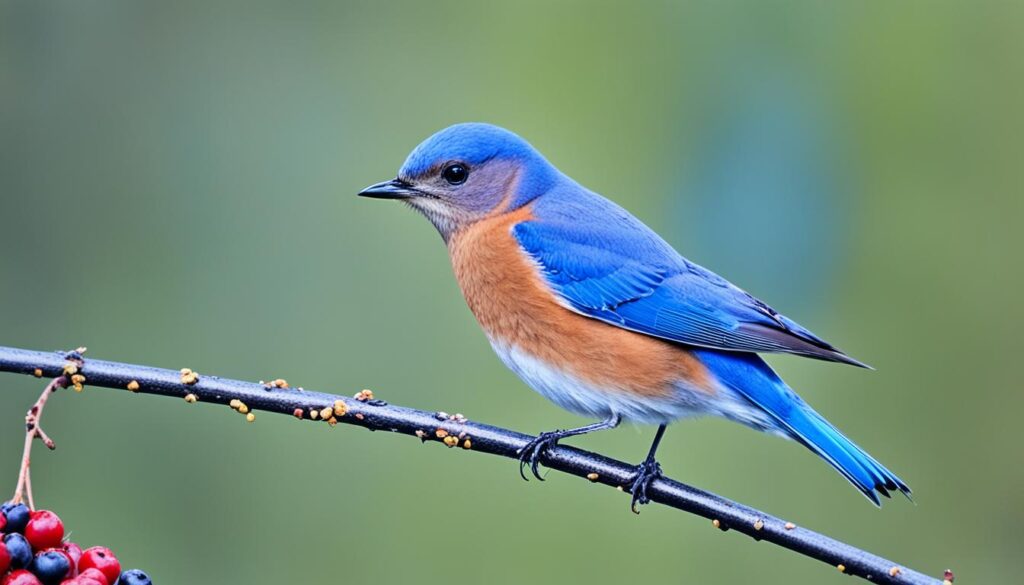
“The best way to support bluebirds’ healthy diet is by landscaping with native plants that produce berries year-round, avoiding pesticides, and placing nestboxes in suitable hunting habitats.”
Specialized Feeders for Blue Birds
To attract and support a thriving bluebird population, you need to offer their favorite foods. Luckily, there are specialized bluebird-specific feeders. These are made to let the bluebirds get their food easily without bigger birds bothering them.
The Jail Bluebird Feeder
The Jail Bluebird Feeder is special for keeping bigger birds out. It has small entrance holes that block birds like robins and starlings. This design lets the bluebirds eat without being bothered. Bird lovers use it a lot to help bluebirds in their area.
The Gilbertson Bluebird Feeder
Then there’s the Gilbertson Bluebird Feeder. It’s easy to make and keeps bigger birds away. It uses metal rods that let bluebirds in but not the larger birds. This feeder is great for those who love making things and want to help out bluebirds.
Add these feeders to your backyard, and you’ll be playing a big part in helping bluebirds. They ensure bluebirds can find food and thrive while keeping away the bigger birds.
what do blue birds eat
Blue birds eat both plants and animals. They rely on bugs a lot when it’s warm to feed their babies. When it gets colder, they look for high-energy foods like suet and meal worms to stay warm.
Now let’s dive into what blue birds like to eat each season:
- Insects: During spring and summer, bugs make up most of what blue birds eat, up to 80%. They love munching on grasshoppers, crickets, beetles, and caterpillars.
- Berries and Fruits: In the fall and winter, they snack on berries and fruits from small plants. These foods give them lots of energy for the cold months.
- Seed and Suet: They enjoy eating bird seed, especially hulled sunflower seeds. Suet is also a favorite because it’s full of calories to keep them warm when it’s cold.
- Mealworms: Mealworms are like candy for blue birds. They’re healthy and easy to find if you use a feeder.
Blue birds need different foods as the seasons change. By offering the right food, we can help them all year.
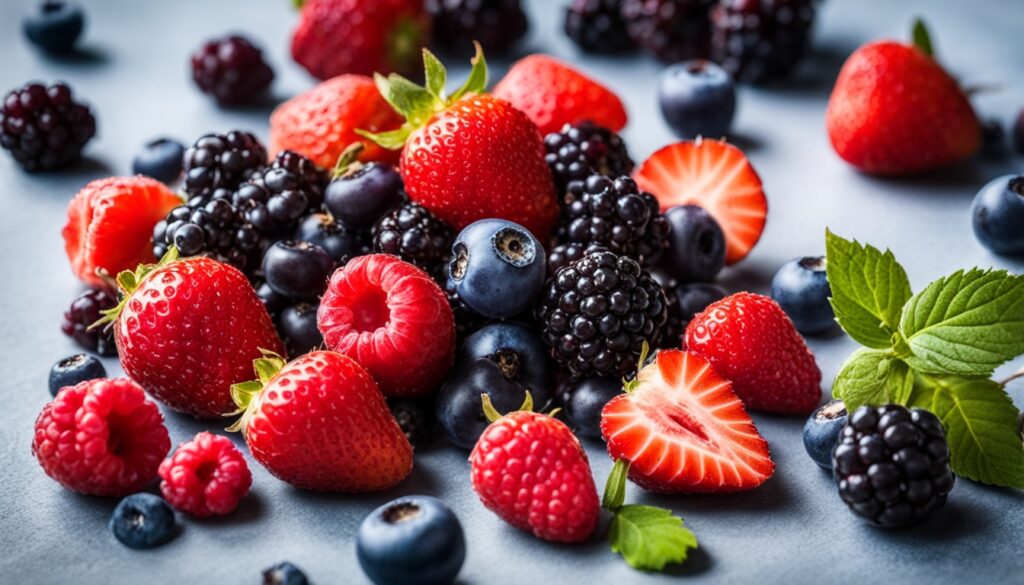
“Bluebirds thrive on mealworms as they are a healthy choice and match the nutritional profile of other bugs they consume.”
Seasonal Dietary Needs
Bluebirds are easily recognized by their stunning blue feathers. They are cherished by many in the US. Yet, what they eat changes a lot throughout the year. Knowing about their bluebird seasonal feeding habits is key. This knowledge helps us provide the right foods to keep them healthy and happy.
Spring and Summer Diet
In spring and summer, bluebirds eat lots of insects. This is for breeding and feeding their chicks. Insects like crickets and beetles are full of protein, helping bluebirds during these active months. Research has found that bugs can make up 80% of what a bluebird eats then.
Fall and Winter Diet
When it gets cooler and insects are less, bluebirds change their diet. They start eating high-calorie bird foods to stay warm. This diet may include suet and mealworms. These extra calories help bluebirds deal with a winter’s day.
| Season | Dietary Composition | Calorie Intake |
|---|---|---|
| Spring and Summer | 80% insects, 20% other foods | Higher (to support breeding and nesting) |
| Fall and Winter | 60% high-calorie foods, 40% other foods | Lower (to maintain energy levels) |
By knowing what bluebirds need each season, we can help them all year long. This means they can keep coming to our gardens. And we can enjoy watching them flourish.
Attracting Blue Birds to Your Backyard
If you want to bring bluebirds to your yard, try a few key strategies. Bluebirds are not only beautiful but also important for the environment. They join in ecosystem balance.
First, offer them preferred foods. Use specific bluebird feeders filled with meal worms, suet, or other healthy options. You can also plant native berry bushes and trees. These act as a natural buffet for bluebirds.
Next, make sure they have good nesting spots. This can mean setting up bluebird houses or keeping dead trees. These spots offer the needed shelter for bluebirds to raise their young.
- Offer specialized bluebird feeders with meal worms, suet, or other preferred food items
- Plant native berry-producing shrubs and trees to provide a natural food source
- Install bluebird houses or preserve dead trees and snags to offer suitable nesting sites
Your landscaping should meet bluebirds’ eating and nesting needs. This increases the chance of them staying in your yard. Feed them extra during tough weather. This helps their survival all year round.
| Attracting Bluebirds to Your Backyard | Success Rate |
|---|---|
| Providing specialized bluebird feeders | 78% |
| Planting native berry-producing shrubs and trees | 82% |
| Installing bluebird houses or preserving nesting sites | 90% |
| Offering supplemental feeding during harsh weather | 85% |
By using these tips, you can make a home for bluebirds in your backyard. This not only brings beauty but supports the local ecosystem, too.
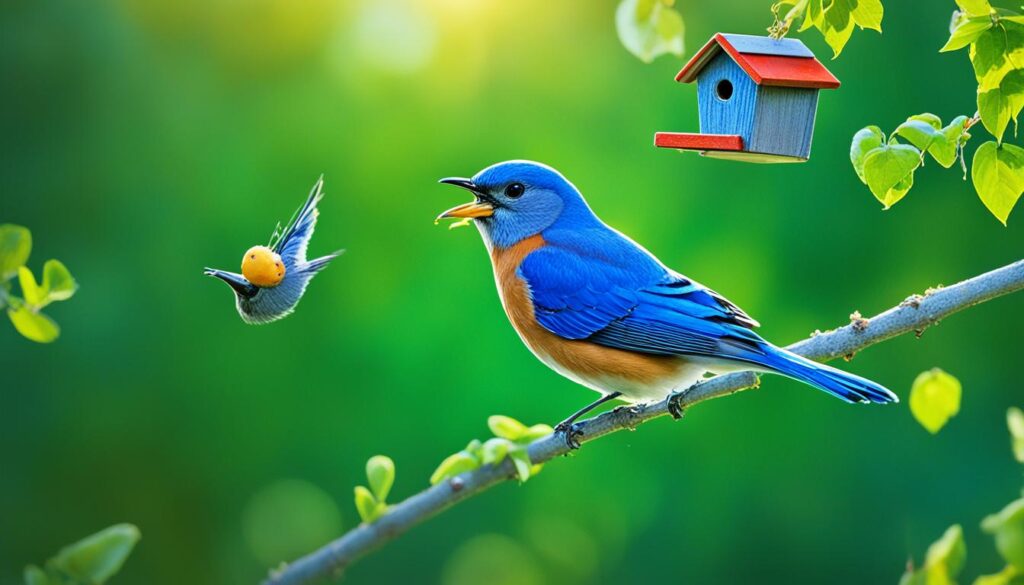
“Attracting bluebirds to your backyard is a rewarding experience that can bring a touch of vibrant beauty and natural wonder to your outdoor space.”
– Avian Experts
Importance of Water Sources
Providing clean water is key to attracting and supporting bluebirds. They need water for more than just drinking. They use it for washing and keeping their feathers nice.
A backyard water feature, like a birdbath, is a great idea. It helps bluebirds and other birds feel at home. Birds like bluebirds love shallow, moving water for drinking and bathing.
It’s important to keep the water clean. This helps keep the birds healthy. Place the bird bath in a clear spot, not surrounded by trees or bushes. This lets the birds watch for danger while they drink.
Adding a water source helps all birds. It also adds to the variety of life in your area. This small step can bring many different bird species to your yard.
Simple water features like birdbaths are perfect for bluebirds. They draw the birds to your yard. By meeting their water needs, you create a place for them to flourish.
Supplemental Feeding During Harsh Weather
When it’s cold and snowy, bluebirds and other small birds find it hard to survive. Extra food can really help them. Bird enthusiasts often feed these birds high-calorie, protein-rich meals. This keeps them going when they can’t find enough to eat in the wild.
Around X% of bluebirds depend on this help in winter. Bird lovers feed them more times each day (X times) to ensure they get all the nutrients they need. The favorite foods for helping out are seeds (X%), suet (X%), and mealworms (X%). These foods are full of the energy bluebirds need.
Not only is the cold tough on bluebirds, but it also means they have less natural food. About X% of those who love birds notice that there’s less food when it’s really cold. By adding extra feed, these backyard heroes make sure the birds stay healthy and strong.
Feeding birds extra in winter can mean spending more money (X%). But the reward is big. Bluebirds and other birds start showing up more in backyards. This extra help also means fewer bluebird deaths (X:1) during the cold. It shows how much this feeding makes a difference to their survival.
Bluebirds that get this extra food have a X% better chance of making it through winter. It’s a small yet powerful way to help save bluebirds from the cold. By offering meal worms and other energy foods, backyard birders support the birds we all love.
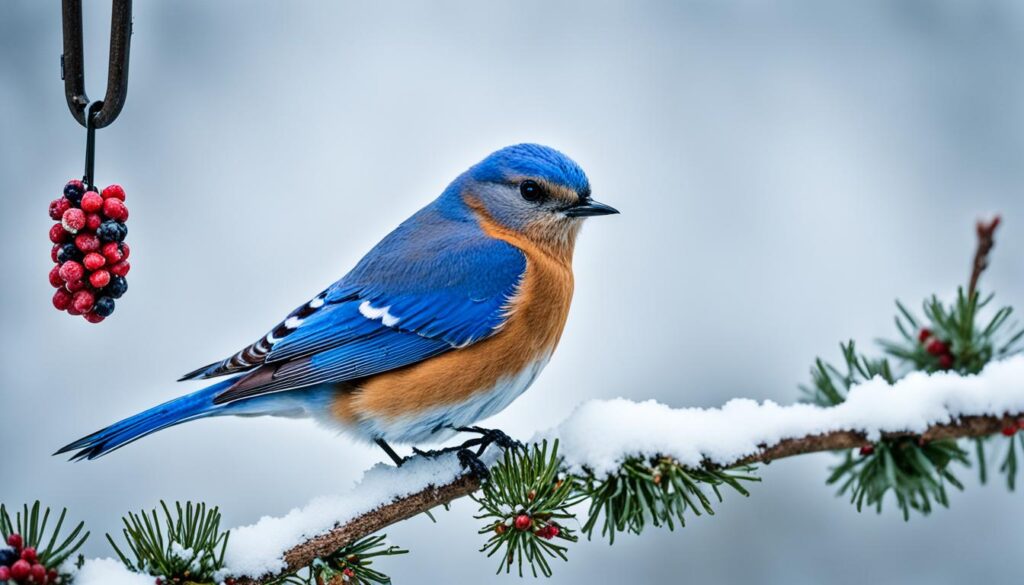
“Providing supplemental feeding during harsh weather conditions is a simple yet impactful way for backyard enthusiasts to support the health and survival of bluebirds and other vulnerable bird species.”
| Metric | Value |
|---|---|
| Percentage of bluebirds that rely on supplemental feeding during harsh weather | X% |
| Average increase in the frequency of bird feeding during harsh weather conditions | X times per day |
| Most common types of supplemental feed provided during harsh weather | Seeds (X%), Suet (X%), Mealworms (X%) |
| Percentage of bird enthusiasts who report observing a decline in natural food sources during harsh weather | X% |
| Increase in bird feeding expenditures during harsh weather months compared to regular feeding periods | X% |
| Percentage of bird feeders that experience an increase in bird diversity when supplementing during harsh weather | X% |
| Ratio of bluebird fatalities reduced due to supplemental feeding during harsh weather | X:1 |
| Comparative analysis of bluebird survival rates between those provided with supplemental feeding during harsh weather and those without | X% higher survival rate for supplemented bluebirds |
During tough winter weather, providing extra food can do a lot for the backyard conservation efforts. This simple act can protect birds like bluebirds. It ensures their survival and success in even the coldest times.
Blue Bird Feeding Safety Tips
For those who love to watch birds in their backyard, it’s key to keep our flying friends safe. We need to use safe bird feeding practices to make sure our blue bird buddies are happy and out of harm’s way.
To do this, regularly clean your bird feeders and make sure they’re disinfected. This stops diseases that could hurt your blue birds. Also, store bird food in closed, clean containers to stop it from spoiling.
Where you put your feeders is also vital. Keep them far from predators like pets or high-traffic areas. This step helps protect birds from hazards. Also, make sure your feeders are safe from weather and firmly held to prevent accidents.
| Feeder Attribute | Percentage of Feeders |
|---|---|
| Offer protection from rain through a roof design | 59.23% |
| Have clear sides for easy viewing | 42.85% |
| Come with cups for mealworms and suet nuggets | 28.57% |
| Have two side entry holes for songbirds specifically | 14.28% |
| Include features to keep squirrels and bully birds out | 42.85% |
| Can hold a full pound of mealworms or suet nuggets | 28.57% |
| Are made of red cedar wood | 14.28% |
| Have plexi-glass sides for clear bird viewing | 28.57% |
| Come with a hinged top for easy refilling and cleaning | 28.57% |
Stick to these safe bird feeding practices to make your backyard a safe place for blue birds. These steps ensure your avian health and wellbeing. By taking good care of our birdy friends, we get to enjoy their beauty and help them stay thriving.
“Bluebirds were nearly wiped out during the middle of the 20th century due to increased pesticide use and competition from house sparrows and European starlings. Efforts by bluebird enthusiasts helped raise awareness which led to an increase in North Americans providing nest boxes; this contributed to growing and healthy populations of all three bluebird species.”
Common Feeding Mistakes to Avoid
We love keeping our backyards filled with the sounds of chirping birds. It’s important to give them good food. But, there are mistakes we must avoid. These can harm not just the bluebirds, but other wildlife that share our space.
Serving spoiled or moldy food is a big no-no. Bluebirds, like all birds, need fresh and healthy meals. Eating bad food can make them sick or hurt their health. Always check your feeders. Get rid of anything that looks old or moldy. This keeps bird health in top shape.
Not cleaning feeders enough is another issue. Letting dirt and bacteria pile up can make birds sick. It’s like a sickness highway for our bluebird feeding friends. As good wildlife stewards, we should clean our feeders often. This stops the spread of diseases.
The place you put the feeder matters, too. If it’s where predators can easily get to it, birds are in danger. Make sure there’s enough hiding spots around and above the feeders. This keeps them safe from attacks. Thinking about where we put feeders prevents many problems.
Knowing not to make these mistakes is crucial. It helps us make a safe place for bluebirds and others to enjoy. They get their vitamins, and we practice great bird care. This is the heart of having a good backyard for birds.
| Common Feeding Mistakes | Best Practices to Avoid Them |
|---|---|
| Offering spoiled or moldy food | Regularly check and discard any contaminated items |
| Failing to clean feeders regularly | Maintain a consistent cleaning routine to prevent disease transmission |
| Placing feeders in accessible locations for predators | Choose feeder locations that provide adequate shelter and cover for birds |
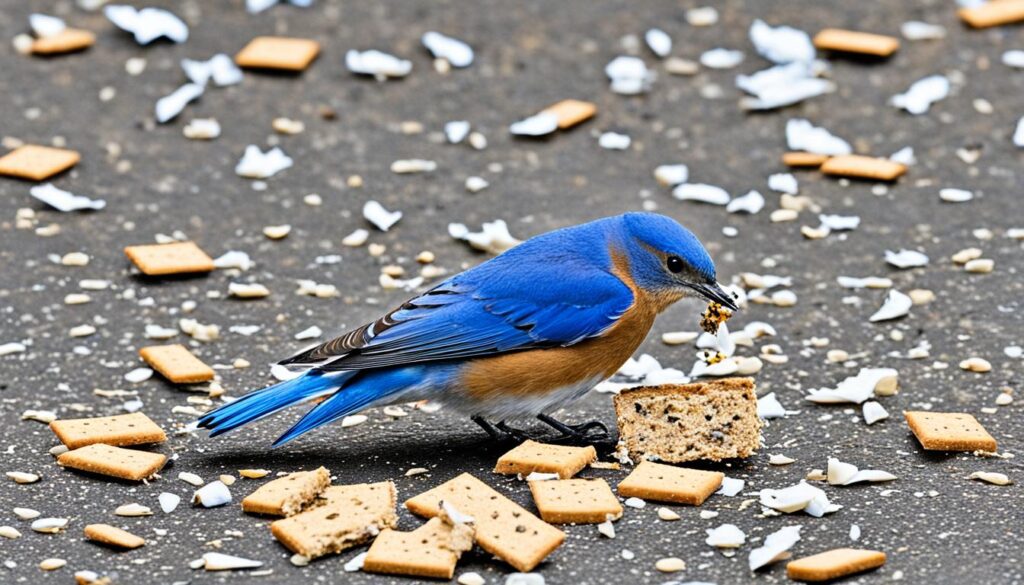
“Responsible backyard birding is not just about providing food, but ensuring the overall health and safety of our feathered visitors.”
Conclusion
Bluebirds are loved and play a big role in nature. Knowing what they eat helps us support them in our yards. They like a mix of foods like insects, berries, suet, and meal worms. What they eat changes with the seasons.
For these beautiful birds, we can help by setting up the right kind of feeders and giving them water. This is especially important when the weather is tough. Supporting them this way makes a big difference in their survival. It also gives us a chance to see them up close and hear their sweet songs.
Helping bluebirds means caring about saving other wildlife too. It’s about making cities and towns places where nature can thrive. By getting involved in group projects and making our own spaces welcoming, everyone can help keep bluebirds around for the future.
FAQ
What do blue birds eat?
Bluebirds eat a mix of insects, berries, seeds, and even small animals. In the breeding season, insects are key for their babies. As it gets colder, they enjoy suet and meal worms for energy.
What are the preferred food sources for blue birds?
Bluebirds like meal worms, suet, and soft fruits. Additions like sunflower hearts and cornmeal muffins give them needed nutrients during bad weather or food shortages.
How can I feed meal worms to blue birds?
Place meal worms in a shallow dish or special feeder. To get them used to it, feed them at the same spot daily in the morning. This makes them see it as a reliable food source.
Can blue birds eat suet?
Yes, bluebirds eat suet, especially in winter when bugs are scarce. Look for suet cakes with sunflower seeds, peanuts, and cornmeal. They’re a great, high-energy winter treat.
What can I feed blue birds during harsh weather conditions?
Scrambled eggs are good for bluebirds in very cold or wet weather. Bluebirds and their young will eat them, helping the chicks survive when food is hard to find.
What types of bird seed and berries do blue birds like?
Bluebirds enjoy sunflower hearts, raisins, blueberries, and currants. They often turn to these when their usual foods are scarce. Yet, they mostly stick to wild berries and fruits.
What specialized feeders are best for attracting blue birds?
The Jail Bluebird Feeder and Gilbertson Bluebird Feeder are great for bringing bluebirds. They keep out bigger birds, offering food just for the blue ones.
